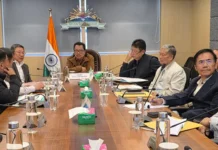Monday Musing
[Amar Sangno]
When it comes to China and Chinese policy, the Indian government, regardless of which political party is at the Centre, always adopts a reluctant and wait-and-watch stand, especially over the strategic border issues in Arunachal Pradesh and Ladakh.
China did stage a ceremonial protest by boycotting the G20 submit in Itanagar on 25 and 26 March, for which around 50 foreign delegates (nearly 100 in total) from G20 nations, including the European Union, came.
Chinese hegemony could be seen and felt significantly as the Itanagar G20 submit was reduced to a mere cultural show, as no official business discussions happened, unlike in Sikkim. However, for a strategic state like Arunachal Pradesh, the G20 event was a golden opportunity to showcase our rich traditions and cultural mosaic to the world. Arunachal proved it when the cultural show received a standing ovation by the awestruck delegates.
“This is the first G20 meeting where I saw standing ovation given to any cultural show” said a Nigerian delegate.
“I am completely awestruck by the diverse and beautiful culture, this is so amazing. I just realised that this is true India. Thank you Arunachal,” exclaimed Dr Kulkarni, a government of India delegate.
However, the irony of the G20 submit was that the external affairs ministry restricted both local and national media from covering the programme, without citing any specific reason. We all presumed that strategic sensitivity could be the reason, as insensible reporting might have jeopardised the meeting. However, every participant witnessing the cultural fiesta was giving live feed on their respective social media page.
As expected, China protested like it routinely does whenever any top Indian leader pays visit to Arunachal, particularly along the line of actual control (LAC). Over the years, China has been stepping up border infrastructures aggressively with its infamous ‘two steps forward, one step back policy’ along the LAC.
The red dragon is indeed breathing fire as it fired a fresh geopolitical salvo at India by renaming 11 places in Arunachal Pradesh (which it calls Zangnam, the southern part of Tibet).
India registered a strong protest with the Chinese high commission in Delhi, declaring that “Arunachal Pradesh is an integral part of India.”
India strategically responded against Chinese’s assertion over Arunachal when union Home Minister Amit Shah air-dashed to Kibithoo, a forward village along the LAC in Anjaw district, recently.
Shah is the first union home minister to have visited the border village (Kibithoo and Walong) in the border history of Arunachal. He stayed overnight at Walong. Former president APJ Abdul Kalam had visited Kibithoo on 15 March, 2007. Shah inaugurated the Vibrant Villages Programme there. He heaped praise over the beauty of Arunachal and urged fellow Indians to visit the easternmost state of India.
“Arunachal Pradesh is blessed with immense natural beauty. I urge all to visit Arunachal Pradesh, especially Kibithoo, to be inspired by its history and stunned by nature’s marvels,” Shah said.
Chinese claims over Arunachal as a disputed territory has been a curse for us. It thwarted the Asian Development Bank’s plan to provide 60 million dollars for watershed programme in Arunachal in 2009.
Now it is high time for the Indian government to switch its policy to secure its border by ramping up infrastructures, and reclaiming the no man’s land in the Himalayas (LAC) to thwart red dragon’s advance.



